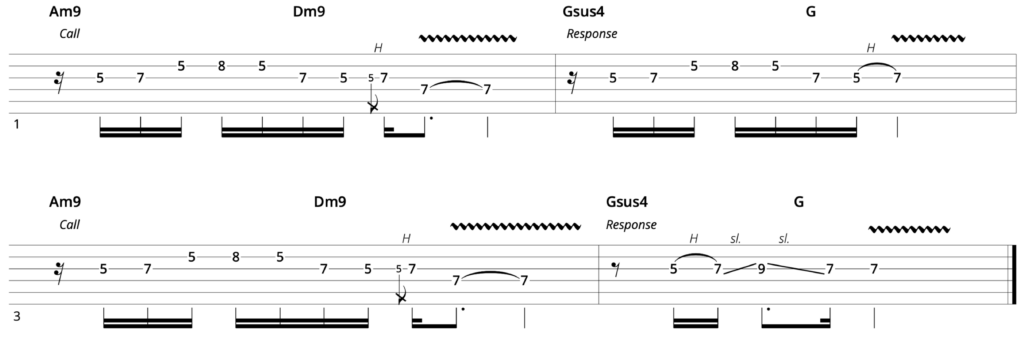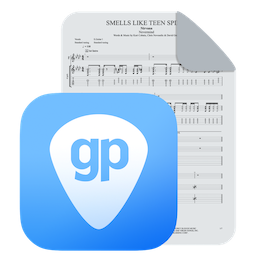
Movable Minor Pentatonic – Solo like a pro guitarist
- moveable_minor_pentatonic.gp
For intermediate guitarists, musical freedom means exploring new territories and pushing yourself out of that comfort zone.
- It’s so common to get stuck in a rut.
- All of us have experienced it at some point.
- One way to break out of the box is by moving it around.
That’s exactly what we’ll do today.
Pickup music founder Sam Blakelock is here to show you the best way to open up the fretboard.
If you’d like to see or hear how to play any of the exercises in this article, check out the video companion.
Why should I learn this?
- Moveable shapes give you the freedom to change keys and open up your fretboard.
- You’ll hit soloing roadblocks unless you get to grips with this fundamental idea.
- Master this basic scale, and you can easily build upon it by adding a few notes – other scales and modes fit around this shape.
E minor pentatonic
You should already be somewhat familiar with the E minor pentatonic scale in its open position.
- To make this into a moveable scale, all we need to do is learn the root notes.
- You can see the root notes (1) highlighted in the diagram below.
- These are our main visual markers for outlining the scale shape.
But, what if we don’t want to play in Em?

Root notes are anchor points
Once you can visualize those root notes within the scale, you’re ready to shift its position up the neck. Moving from the open E position to the A position is simple – just slide everything up to the 5th fret.

One big difference is that you now need to fret all those notes that were open strings in E. You can think of your index finger as a moveable nut – like we do with bar chords.
- If you know your E minor shape bar chord, strum it.
- You’ll see how it fits perfectly inside the minor pentatonic pattern.

It’s important to dial in your muscle memory when learning these patterns too. Choose specific fingers for each note within the pattern – then you just need to move that root note on the low E string, and your fingers will automatically do the rest.
Here’s the best way to play this pentatonic pattern:
- On the A, D, and G strings, use your index and ring fingers.
- On the E and B strings, use your index and pinky fingers.
- Certain situations may call for you to use different fingerings, but for now, stick to these.
Your pinky finger might feel a little weak if you’re not used to using it, but we’ve got some tips to help with that.
4 tips for scale success
We’ll get into the exercises in just a moment. Before we do, here are a few technique tips to make life easier.
#1 – Finger placement
Precision in where you place your fingers on the frets can significantly affect the sound quality.
- Aim for the upper third of the fret (close to the metal fretwire).
- This will give you a cleaner note with less pressure.
#2 – Keeping fingers close
Minimize the movement of your fingers away from the fretboard to increase efficiency and speed. This is especially true for the pinky finger, which tends to fly away whenever you’re not looking.
#3 – Light touch
Avoid pressing too hard on the strings.
- Gentle pressure is often enough to produce a clear tone.
- You want to find the perfect balance.
- Less strain means happy hands!
#4 – Slow and Steady
Practice slowly to ensure accuracy and build speed gradually.
- Mastery comes with patience and consistent practice.
- It’s only when you’re first learning something that you need to pay such close attention – soon it will be second nature.
Exercise 1. A minor pentatonic in position
You’ve got to start off simple. A strong foundation means everything you build on top will be rock-steady.
All we’ll do is work our way up and down the A minor pentatonic scale – don’t rush, we want to make it perfect.
- Set your metronome to a tempo that feels slightly too slow – we’re focusing on accuracy, not speed.
- Remember those tips – good finger placement, with even pressure for every note.
- To begin with, use all downstrokes when ascending and descending the scale.
- When you feel more confident you can switch to alternate picking and increase the tempo slightly.
Once you’re happy with that, we can move on to something a little more musical.
Lick – Level 1
Let’s put this new scale position to good use. Here’s a simple lick within the A minor pentatonic shape you just learned.

- Start on the 5th fret of the G string.
- Use an upstroke for the first note and then continue with alternate picking.
- Downstrokes on the downbeats – upstrokes on the upbeats.
In this lick we’re mainly focused on the picking hand. An important part of being an intermediate-level guitarist is analyzing the little details of how you play something.
If we attempt a lick like this with all downstrokes it’ll feel awkward and put strain on the picking hand, so we find a more efficient way to play it – alternate picking.
Lick – Level 2
Self-expression is all about how you deliver something. Just like our tone of voice when we speak, the way we phrase a lick is just as important as the notes themselves.

The notes are the same as the previous lick, but we’re breathing new life into it with some added techniques.
- Add a hammer on from the 5th to 7th fret.
- Give the last note some style with a little vibrato.
- Be intentional with your vibrato, it’s more than just wiggling the string.
Read this in-depth guide to bends and vibrato if you want to learn more.
Lick – Level 3
Let’s play a little solo using different variations of the lick. A great way to craft a singable solo is by using short repeating phrases and adding small changes each time. This gives the listener a sense of melody and a memorable hook. The ‘call and response’ approach is a classic for guitarists – so let’s try it out.


It looks like a lot on the TAB, but when we break it down, you’ll see how straightforward it is.
- Phrase 1 is just ‘Lick – Level 2’. Remember to alternate pick each note.
- Phrase 2 is exactly the same, except we leave off the last note. Simple but effective.
- Phrase 3 – Repeat Phrase 1
- Phrase 4 is the big finale – we go up to the 9th fret.
The 9th fret isn’t in our shape! What’s going on?
Scale shapes are guides, not boundaries. Moving to the 9th fret allows us to slide into the note, which adds another layer of style to the phrase. You could just play the 5th fret on the B string (it’s the same note), but it doesn’t sound as cool as the slide in.
Moving on up
It’s amazing how musical one shape and a few simple lines can be.
- When you understand the power of simplicity you’ll grow as a guitarist.
- Some of the most iconic guitar solos are rooted in what we learned today.
- Be mindful and musical with each note you play and you’ll sound great.
This lesson was a snippet from Pickup Music’s Intermediate Learning Pathway. If you’re looking for a clear structure to keep your practice routine on track, check them out.
They’re currently offering a 14-day free trial which includes full access to all of their lessons and 1-on-1 personalized feedback.
This lesson is a game-changer for intermediate guitarists that want to increase their fretboard awareness. Pickup Music founder Sam Blakelock will show you how to break free from the common ruts by using moveable shapes. This allows for easy key changes and a whole new level of fretboard freedom.
Why this lesson?
Understanding how to move the minor pentatonic scale around the neck is crucial for avoiding soloing roadblocks. Plus, you’ll get some techniques to ensure clean, precise playing – and put that pinky finger to work!
You’ll Learn
- The Power of Root Notes: Learn how to use root notes as visual markers to navigate the fretboard effortlessly.
- Making the Scale Moveable: Discover how shifting the scale’s position can open up new musical possibilities.
- Technique Tips for Success: From finger placement to maintaining a light touch, we’ve got you covered with essential tips that make playing more efficient and enjoyable.
- Exercises and Licks: Start with basic exercises to solidify your foundation, then move on to musical licks that apply what you’ve learned in a creative context.
Whether you’re looking to explore new keys, improve your soloing skills, or just make your practice sessions more productive, this lesson has something for everyone. Dive deeper into your guitar journey with Pickup Music’s Intermediate Learning Pathway.
Sign up for a free 14-day trial today and get full access to all our lessons, complete with 1-on-1 personalized feedback to help you grow.
Go check out Pickup music:
🔗 Website.
📸 Instagram: @pickupmusic
♩ TikTok: /pickupguitar
Leave a comment
Your email address will not be published.
| Title | Artist | |
|---|---|---|
Black Night

|
Deep Purple | |
Bad Medicine

|
Bon Jovi | |
A Whiter Shade of Pale

|
Procol Harum | |
| Bad Medicine | Bon Jovi | |
Lay Your Hands on Me

|
Bon Jovi |

